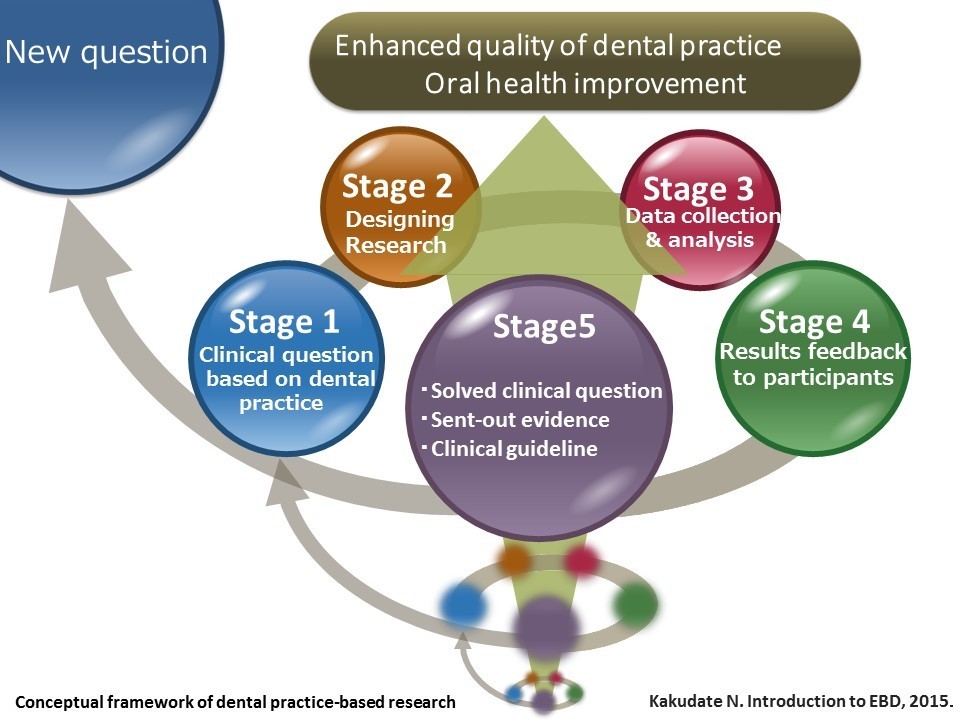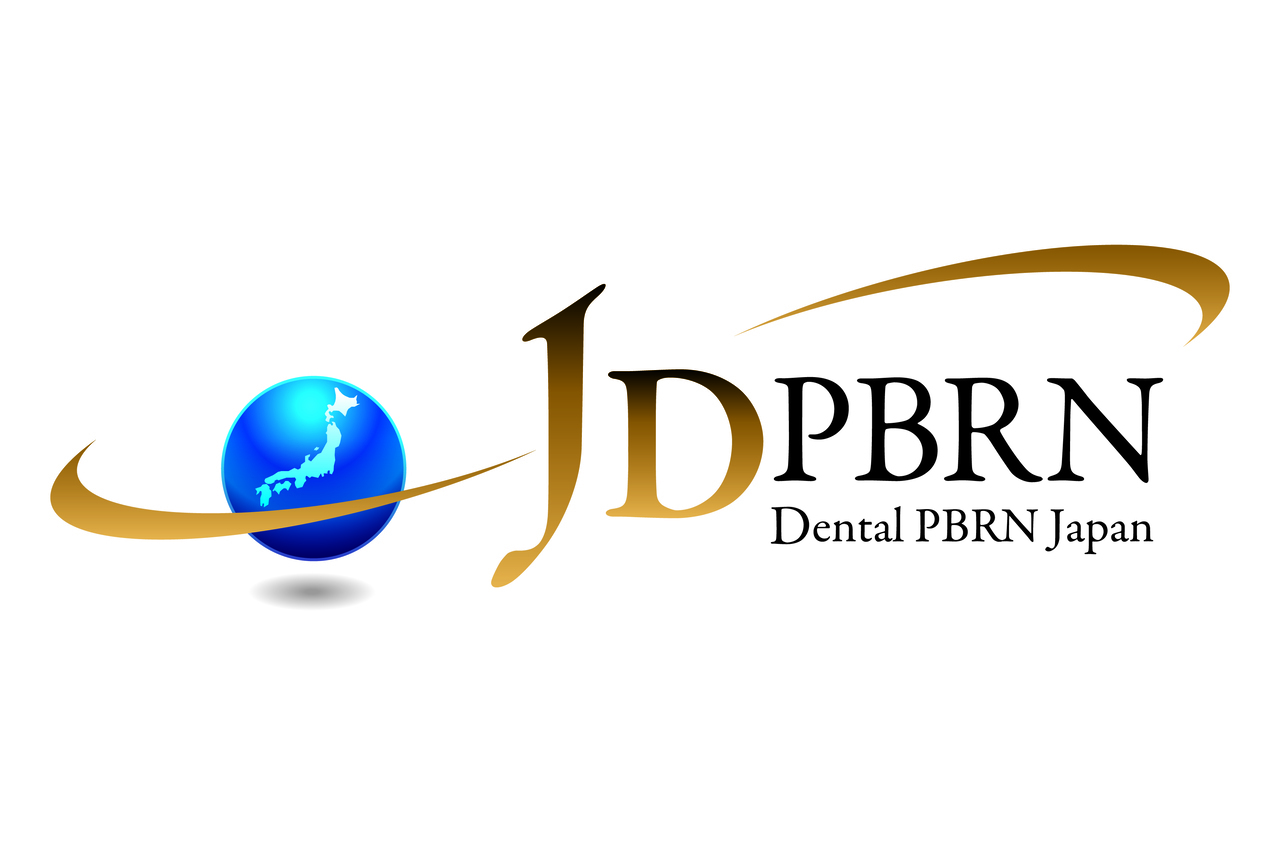Japan-US Collaborative Study No.1 “Assessment of Caries Diagnosis and Caries Treatment in Japan”
Research by the US National Dental PBRN has reported that the pattern of dental treatment in dental caries diagnosis and treatment varies among dentists and regions. In Japan, few studies have compared Japanese and international patterns of care. To clarify the variation in caries diagnosis and caries treatment in Japan and to compare this variation with previous data from the US and North Europe, we conducted an international joint research program using the Japanese version of the questionnaire developed by the US National Dental PBRN Study "Assessment of Caries Diagnosis and Caries Treatment".
[Published Evidence (Peer reviewed publications)]
1. Yokoyama Y, Kakudate N, Sumida F, Matsumoto Y, Gilbert GH, Gordan VV (2016). Practice-evidence gap for dental sealant application results from in a dental practice-based research network. International Dental Journal 66(6):330-336.
https://www.ncbi.nlm.nih.gov/pubmed/27466073
2. Yokoyama Y, Kakudate N, Sumida F, Matsumoto Y, Gilbert GH, Gordan VV (2016). Practice-Evidence Gap for In-office Fluoride Application in a Dental Practice based Research Network. Journal of Public Health Dentistry 76(2):91-97.
https://www.ncbi.nlm.nih.gov/pubmed/26235360
3. Kakudate N, Sumida F, Matsumoto Y, Yokoyama Y, Riley JL 3rd, Gilbert GH, Gordan VV (2015). Dentists’ decisions to conduct caries risk assessment in a Dental Practice-Based Research Network. Community Dentistry and Oral Epidemiology 43(2):128-134.
https://www.ncbi.nlm.nih.gov/pubmed/25175077
4. Kakudate N, Sumida F, Matsumoto Y, Yokoyama Y, Gilbert GH, Gordan VV (2014). Dentists' decisions about occlusal caries treatment thresholds in Dental PBRN. Operative dentistry 39(5):473-480.
https://www.ncbi.nlm.nih.gov/pubmed/24809540
5. Yokoyama Y, Kakudate N, Sumida F, Matsumoto Y, Gilbert GH, Gordan VV (2013). Dentist’s Practice Patterns and the Promoting Factors of Preventive Dentistry in a Dental Practice-Based Research Network. BMJ Open 3(9):e003227.
https://www.ncbi.nlm.nih.gov/pubmed/24068763
6. Yokoyama Y, Kakudate N, Sumida F, Matsumoto Y, Gilbert GH, Gordan VV (2013). Dentists' dietary perception and practice patterns in a dental practice-based research network. PLoS One 8(3):e59615.
https://www.ncbi.nlm.nih.gov/pubmed/23536883
7. Kakudate N, Sumida F, Matsumoto Y, Yokoyama Y (2013). The Development of the Japanese Dental Practice-Based Research Network. Journal of the Pakistan Dental Association 21(3): 162-163 [Guest editorial].
8. Kakudate N, Sumida F, Matsumoto Y, Manabe K, Yokoyama Y, Gilbert GH, Gordan VV (2012). Restorative Treatment Thresholds for Proximal Caries in Dental PBRN. Journal of Dental Research 91:1202-1208.
https://www.ncbi.nlm.nih.gov/pubmed/23053847
Japan-US Collaborative Study No. 2 “Primary Care Management for TMD Pain in Japan”
Temporomandibular disorders (TMD) is a common condition which is characterized by painful and dysfunctional opening of the mouth, with a major impact on the quality of life. To date, no standard treatment for TMD has been established. Current treatments include mouth guards, administration of analgesics, and guidance on self-care, and are administered at the judgment of the individual dental physician and dental practice site. While a study by the US National Dental PBRN clarified that treatment for TMD-related pain in the US varies among individual dentists, no study has examined this issue in Japan. Therefore, we conducted an international collaborative research study on clinical patterns of care for TMD-related pain in Japan.
[Published Evidence (Peer reviewed publications)]
1. Yokoyama Y, Kakudate N, Sumida F, Matsumoto Y, Gordan VV, Gilbert GH (2018). Dentist's distress in the management of chronic pain control: the example of TMD pain in a Dental Practice-based Research Network. Medicine 97(1):e9553.
https://www.ncbi.nlm.nih.gov/pubmed/29505535
2. Kakudate N, Yokoyama Y, Sumida F, Matsumoto Y, Gordan VV, Gilbert GH, Velly AM, Schiffman EL (2017). Dentist practice patterns and therapeutic confidence in the treatment of pain related to temporomandibular disorders in a dental practice-based research network. Journal of Oral and Facial Pain and Headache 31(2):152-158.
https://www.ncbi.nlm.nih.gov/pubmed/28437512
Japan-US International Collaborative Study No. 3 “International comparison of the Evidence-Practice Gap (EPG) and an educational intervention aimed at improving the gap”
This study was an international collaborative research undertaken using a grant, "Grant-in-Aid for Scientific Research (C) by the Japan Society for the Promotion of Science (2016-2020)". Various Evidence-Practice Gaps in dental practice were evaluated, and the results were internationally compared between Japan and US in an attempt to help improve dental practices. We conducted a before-after intervention study and a qualitative study. Two web-based questionnaire surveys were performed. The first survey was partially modeled by US National Dental PBRN Study "Impact of Dental Practice-Based Research Networks on Patient Care". At the second survey, we gave educational feedback to the participants so that they may improve their practices by updating them with the latest evidence and evaluated its educational effects.
[Published Evidence (Peer reviewed publications)]
1. Kakudate N, Yokoyama Y, Sumida F, Matsumoto Y, Yamazaki H, Touge T, Fujikawa Y, Gordan VV, Gilbert GH (2020). Evidence-practice Gap in Minimal Intervention Dentistry: Findings from a Dental Practice-based Research Network. Journal of Dentistry 102:103469.
https://pubmed.ncbi.nlm.nih.gov/32916232/
2. Kakudate N, Yokoyama Y, Sumida F, Matsumoto Y, Gordan VV, Gilbert GH (2019). Dentists' practice patterns of treatment for deep occlusal caries: Findings from a dental practice-based research network. Journal of Dentistry 84:76-80.
https://www.ncbi.nlm.nih.gov/pubmed/30935965
[Web-based questionnaire items]
1. First questionnaire items.pdf
Japan-US-Brazil International Collaborative Study No. 4 “An international comparative study for clarifying the mechanism of the evidence-practice gap and planning improvement strategies”
3http://www.dentalpbrn.jp/_p/acre/25660/documents/EPG_second_English.pdfThis study was funded by "Grant-in-Aid for Scientific Research (C) by the Japan Society for the Promotion of Science (2020-2025)". This is the first international collaborative practice-based research between Japan and Brazil. Data collection in Brazil is being conducted by Dr. Elaine Pereira da Silva Tagliaferro, Professor of Dentistry at São Paulo State University (Unesp). The questionnaires were developed by the JDPBRN in Japanese and Brazilian languages, partly based on the Practice Impact Questionnaire developed by the National Dental PBRN in the US. Two web-based questionnaire surveys were completed.
The ultimate goal of this study is to identify the mechanisms underlying the evidence-practice gap between the two countries and to suggest strategies to improve it.
[Published Evidence (Peer reviewed publications)]
1. Kakudate N, Yokoyama Y, Tagliaferro E, Sumida F, Matsumoto Y, Gordan VV, Gilbert GH (2024). Comparison of Factors Associated with the Evidence-Practice Gap as Perceived by Japanese and Brazilian Dentists. Journal of Dentistry 149:105255.
https://pubmed.ncbi.nlm.nih.gov/39079315/
2. Kakudate N, Yokoyama Y, Tagliaferro E, Sumida F, Matsumoto Y, Gordan VV, Gilbert GH (2024). The Evidence-practice Gap in Minimal Intervention Dentistry: An International Comparison Between Dentists in Japan and Brazil. Operative Dentistry 49(2):127-135.
https://pubmed.ncbi.nlm.nih.gov/38196080/
[Web-based questionnaire items]
1. First questionnaire items in Japanese
2. First questionnaire items in Portuguese
JDPBRN original study No.1 “Use of clinical practice guidelines by dentists in Japan”
To practice Evidence-based Dentistry, dental treatment should utilize clinical practice guidelines based on the highest levels of evidence. Many clinical practice guidelines have been developed in Japan, but the degree to which they are utilized in actual dental practice sites has not been clarified. This cross sectional study aimed to clarify 1) to what degree are guidelines utilized in the Japanese dental field; and 2) what factors are related to dentist utilization of guidelines.
[Published Evidence (Peer reviewed publications)]
1. Kakudate N, Yokoyama Y, Sumida F, Matsumoto Y, Gordan VV, Gilbert GH. Use of clinical practice guidelines by dentists: findings from the Japanese dental practice-based research network. Journal of Evaluation in Clinical Practice 23(1):96-101.
https://www.ncbi.nlm.nih.gov/pubmed/27491703.
JDPBRN original study No.2 “What is the practice-based research needed by the patients in Japan?”
In the Selection of Research Questions (SRQ), the JDPBRN asked its members "what questions need to be resolved in dental practice?" From the responses, "What kind of Practice-based Research (PBR) is needed for dental patients?" was selected by the core committee as a topic of JDPBRN original research in 2012. At the 3rd academic meeting of the society, a workshop on this topic was held to discuss the questionnaire items. Patient questionnaire surveys have been completed in Japanese dental clinics in 2016 as a clinical study of JDPBRN.
[Published Evidence (Peer reviewed publications)]
1. Kakudate N, Yokoyama Y, Sumida F, Matsumoto Y, Riley JL 3rd, Gordan VV, Gilbert GH (2019). Practice-based research agenda priorities selected by patients: findings from a dental practice-based research network. International Dental Journal 69(3):183-191.
https://www.ncbi.nlm.nih.gov/pubmed/30350855
[This paper was introduced and summarized in "British Dental Journal (2019; 227(2):113)".]
Steps of the JDPBRN study process
This is an introduction of the steps of JDPBRN study process.
1) The collected Research Questions are submitted to the Core Committee to be approved.
2)Then Research Committee prepared a Protocol to apply for approval of the Ethical Review Board.
3)Once the approval of the Ethical Review Board is obtained, the data collection begins in the entire network officially.
4) The data from the patients or the medical records are obtained from each dental clinic to perform the data analysis by the Data Analysing staffs of Reseach Committee in the JDPBRN.
5) After the completion of data analysis, the Principal Investigator presents the results at conferences or writes papers. The results are presented at local, national, or international scientific societies and eventuallythe papers are published in a journal.
6) The results are fed back to the network members for the purpose of improving daily dental practice. Each member compares between data from the research and from their own clinic to develop their routine practice, which will generate additional ideas for further research as a cycle.


